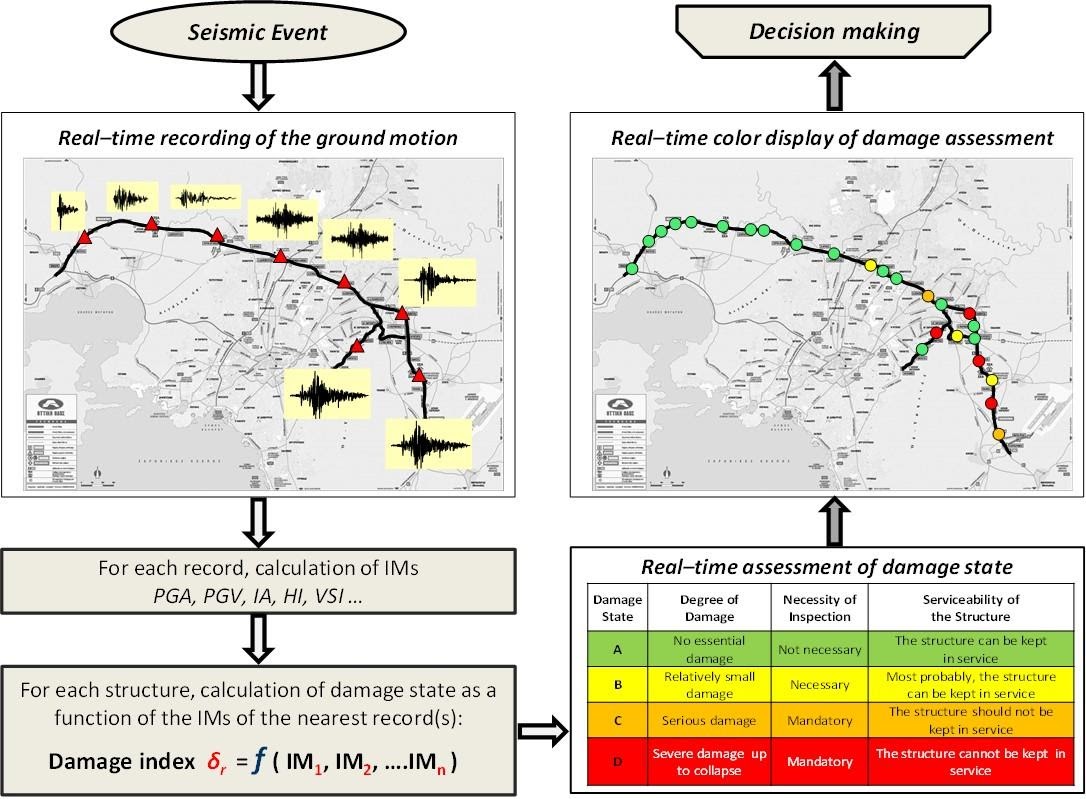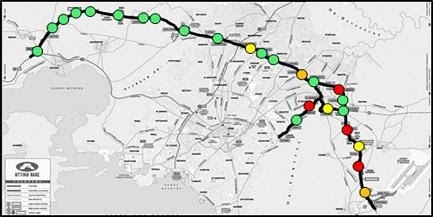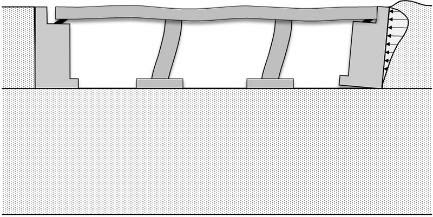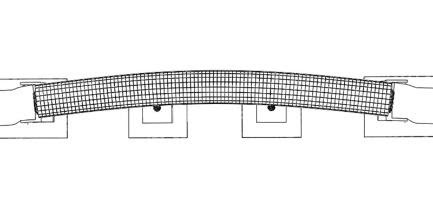Real-Time Earthquake Crisis Management
In the event of a strong earthquake, the safety of motorway users is directly related to the seismic performance of motorway infrastructure. Seismic damage of bridges may pose a severe threat to the users, and preventive closure until post-seismic inspection may be viewed as the only option. However, this may incur pronounced losses by obstructing transportation of rescue teams. On the other hand, allowing traffic on damaged bridges is a difficult decision with potentially dire consequences. The main dilemma for the motorway administrator is whether to interrupt network operation, calling for timely development and implementation of a RApid REsponse (RARE) system.
As part of the FP7-funded “RARE” research project, we introduced a simple method for real time seismic damage assessment of motorway bridges (external page J67). The method requires nonlinear dynamic time history analyses using multiple seismic records. Based on the results of the analyses, statistical models are estimated, and nonlinear regression equations are developed to express seismic damage in function of statistically significant intensity measures (IMs). Such equations are easily programmable and can be employed for real-time damage assessment, as part of an online expert system. In the event of an earthquake, the nearest seismic motions (recorded by an online accelerograph network) will be used in real time to estimate the damage state of motorway structures. The efficiency of the proposed method was demonstrated using a single bridge pier as an illustrative example.

Developing such equations for an entire motorway requires substantial computational effort. For a single bridge, about 350 nonlinear dynamic time history analyses are required to generate a statistically significant dataset. Such an effort would not be easily implementable at the level of an entire motorway, which typically includes hundreds of bridges. To allow implementation of the RARE system, we developed an efficient analysis methodology (external page J68), accounting for key structural components (deck, abutment bearings) and soil–structure interaction (SSI). Rigorous 3D models of a typical overpass bridge were developed and used as benchmark to assess its efficiency. The proposed simplified model is composed of a SDOF system of a pier with springs and dashpots connected at the top, representing the deck and the abutment bearings. Its definition requires section analysis of the pier, and computation of spring and dashpot coefficients using simple formulas. The simplified model was extended to account for nonlinear soil–structure interaction, replacing the soil–foundation system with springs and dashpots. A further extension was made to account for the effect of abutment stoppers (external page J72, external page J76), as well as the first steps for pilot application to Attiki Odos (external page J80).

Selected recent publications

Anastasopoulos I., Anastasopoulos P. Ch., Agalianos A., Sakellariadis L. (2015). “Simple method for real-time seismic damage assessment of bridges”, Soil Dynamics and Earthquake Engineering, 78: 201-212 (external page J67)

Agalianos A., Sakellariadis L., Anastasopoulos I. (2017). “Simplified method for the seismic response of motorway bridges: longitudinal direction – accounting for abutment stoppers”, Bulletin of Earthquake Engineering, 15(10): 4133-4162 (external page J72)

Sakellariadis L., Agalianos A., Anastasopoulos I. (2018). “Simplified method for real‐time seismic damage assessment of motorway bridges: Transverse direction—Accounting for abutment stoppers”, Earthquake Engineering and Structural Dynamics, 47(6): 1496-1521 (external page J76)